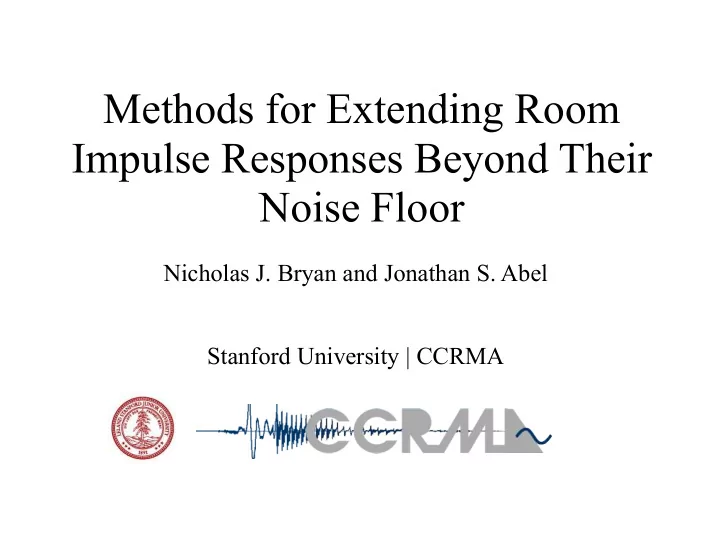

Methods for Extending Room Impulse Responses Beyond Their Noise Floor Nicholas J. Bryan and Jonathan S. Abel Stanford University | CCRMA
What is the problem? • Frequency dependent noise floor limits the perceptual quality of reverberant impulse responses • Unnaturally emphasized high-frequency content and low-frequency measurement noise
Impulse Response Spectrograms EMT 140 Measured Impulse EMT 140 Extended Impulse Response Spectrogram Response Spectrogram
Late-field Reverberation Overview
Late-field Measurement Model • Gaussian noise with a frequency dependent decaying exponential energy profile = Noise Floor = Equalization Level = Time Constant
Preprocessing + Estimation • Two methods for estimating the frequency dependent parameters: – Synthetic Extension Analysis – Natural Extension Analysis • Analysis methods correspond to extension methods • Prior to estimation, preprocessing of the IR is needed
Preprocessing • Decompose impulse response into separate bands via a filter bank • Apply smoothing filter resulting in frequency- dependent energy profiles
Filter Bank • Perfect amplitude reconstruction zero-phase filter bank via a cascade of squared Butterworth filters Frequency dependent energy profiles
Synthetic Extension Analysis • First estimate noise floor arrival time • Estimate the decay rate and equalization level prior to the noise floor arrival
Natural Extension Analysis • Simultaneously estimate the noise floor level, decay time, and equalization level • No assumption of above the noise floor
Extension Methods • Synthetic Extension Synthesis – Crossfade synthesized measured impulse response bands with synthesized bands prior to the noise floor arrival • Natural Extension Synthesis – Window the noise floor found within the measured IR and leverage the measured, natural signal statistics
Synthetic Extension • Cross fade synthetically generated Gaussian noise bands • Window bands according to the estimated parameters Crossfade Between Measured and Synthesized Noise Bands
Natural Extension Synthesis • Window the measure noise bands to effectively “bend down” the undesirable noise floor Numerator bends the energy profile back down Denominator bends the energy profile up
Results Extended Hagia Sophia Balloon Measured Hagia Sophia Balloon Pop Spectrogram Pop Spectrogram
Results Measured and Extended Hagia Measured and extended Hagia Sophia Balloon Pop Response Sophia Energy Profiles
Results EMT 140 Measured Impulse EMT 140 Extended Impulse Response Spectrogram Response Spectrogram
Sound Examples EMT140 long (cutoff ending) EMT140 short (late-field hiss) EMT140 long extended EMT140 short extended Hagia Sophia (late-field hiss + talking) Hagia Sophia extended
Conclusions • Two methods for extended room impulse responses beyond their measured noise floor – The first method crossfades synthetically generated noise with the measured IR – The second method windows the naturally found late- field noise • Both methods maintain an identical impulse response prior to the noise floor arrival and impose a natural sounding decay afterward
Acknowledgements & Thank You! • Stanford University Presidential Fund • Stanford Institute for Creativity and the Arts (Sica) for the Icons of Sound Project (http://iconsofsound.stanford.edu) • Additional support was provided by Universal Audio in a research collaboration with CCRMA
Recommend
More recommend